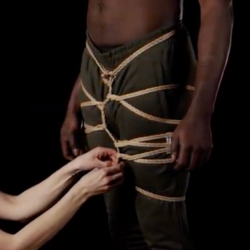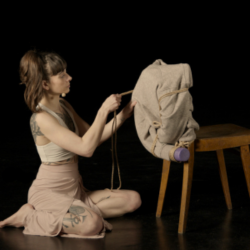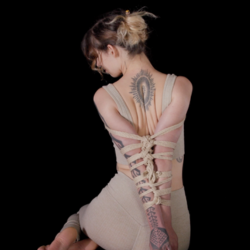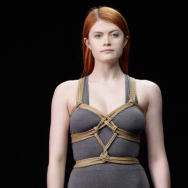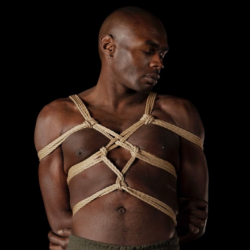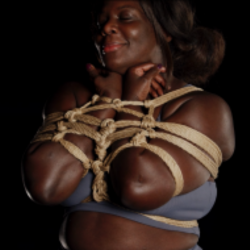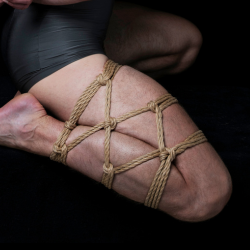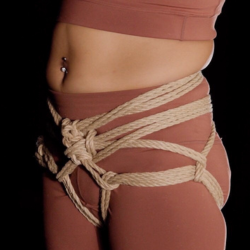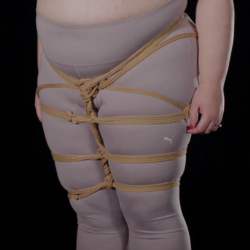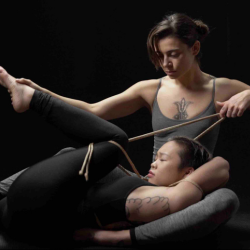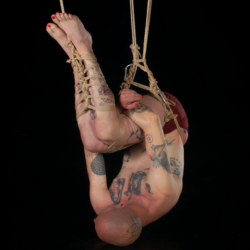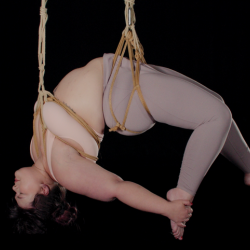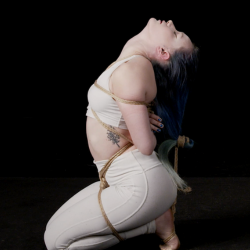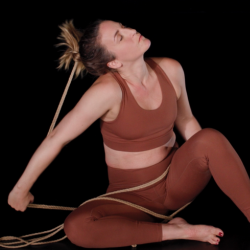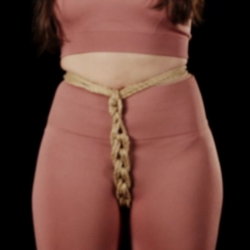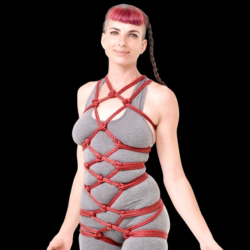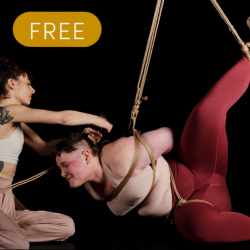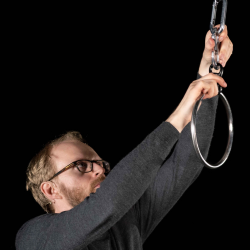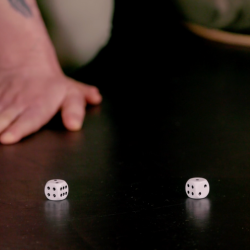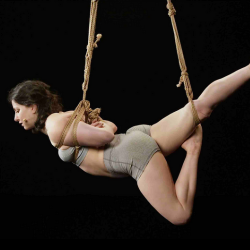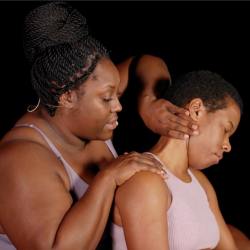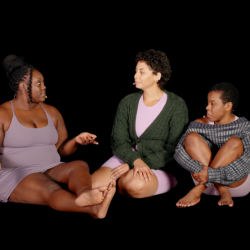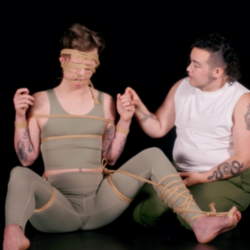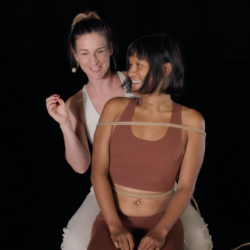EP 48
SHAY TIZIANO
No one's ever died from futo! Shay Tiziano discusses transitioning from LARPing to kink, exhibitionism, incorporating camp into performances, and the importance of active bottoming. They also cover event production, teaching rope, and their upcoming book.

Shay Tiziano (she/her or they/them) is a dynamic presenter and self-suspender renowned for their innovative, acrobatic bondage performances and friendly, attainable, and risk-mitigation-focused approach to kink education. She is the author of Tying & Flying, the first-ever book about self-suspension, and Creating Captivating Classes, a guide for kink and sexuality educators.
Based in San Francisco, Shay is the stages & entertainment co-lead for the Folsom Street Fair and produces the acclaimed bondage and fetish performance event Twisted Windows. She hosts events including BENT, Rope Lab, and Friction, as well as curating performance showcases for the Seattle Erotic Art Festival Aerial & Bondage Stage, Tethered Together, Ropecraft, and San Francisco Pride’s Leather Alley.
Instagram: @shaytiziano
[00:00:09] Wren Hello to all my guys, gals and non-binary pals. Welcome to the Shibari Study Podcast. I'm your host, Wren Shibari Study is an online learning resource offering video tutorials for beginners through advanced practitioners. Whether you're brand new to the world of shibari and needing to learn the basics, or a seasoned rigger or rope bottom seeking inspiration to push your practice to new places, there's something for you at shibaristudy.com. Today, I'm talking to Shay Tiziano. Shay uses she/they pronouns and is based in the Bay area. Shay is a performer, is an event producer, shay serves on the board of Folsom Street Fair, has produced Twisted Windows, Shay does everything in the world and more. You're an incredible person, and I can't wait to chat with you.
[00:00:59] Shay Tiziano You're so sweet. I'm so honored to be on the pod. Thank you.
[00:01:02] Wren You're so welcome. You were telling me that before getting into (…), you're into LARPing.
[00:01:09] Shay Tiziano I was, before getting into the (…) scene, I was a big live action roleplay geek. I used to do a lot of White Wolf Tabletop, mage was my favorite and also did vampire LARP. We used to have a big vampire LARP at the college locally. We had, I think at one point almost 100 people. We also got to do one at a masonic temple, which was very, very cool. So yeah, once I got into the (…) scene, I feel doing (…) roleplay kind of scratched a lot of the same itches. And I really, as, as you said, I do a lot of things in the (…) community, so I try to keep myself to one expensive and time consuming hobby at a time, which for now is (…) and rope.
[00:01:56] Wren Yeah, yeah, yeah, you really can't do both or else you're going to go bankrupt. Anybody would.
[00:02:02] Shay Tiziano Yes. It's a lot to do everything at once. I was talking with a friend of mine who used to be very involved in the rope scene locally, but I hadn't seen her around. I saw her at a party, and I asked her, you know, Hey, what have you been up to, we haven't seen you. She's like, Oh, I haven't been doing rope because I took up horseback archery" And I was like, Oh, well, I can see how that would crowd out the other thing.
[00:02:28] Wren All your time and commitment. Yes.
[00:02:30] Shay Tiziano Yeah. Kind of. So one hobby at a time. I unfortunately haven't been able to do much live action role playing except, you know, performing and doing (…) roleplay, kind of similar, I think.
[00:02:44] Wren In similar veins. I do have a question. I don't understand how you didn't know about (…), but were into LARPing, because I feel like everyone that is into LARPing is in a (…) in some way.
[00:02:56] Shay Tiziano The Venn diagrams definitely are almost just a circle. I agree, I agree completely. I, mostly because I was, you know, 16 when I got into LARPing, so it had to wait until – the minute I turned 21, I went out to [00:03:12]Bondage a Go Go. [0.6s] I came into the (…) scene in Minneapolis and we had a [00:03:15]Bondage a Go Go [0.5s] out there where we had a (…) who spanked people in the play space, clothespins, things like that. So basically, the minute I turned 21, I kind of switched over to the (…) community.
[00:03:30] Wren Got it. You don't hear about the Minneapolis (…) scene very often. How was it?
[00:03:37] Shay Tiziano It was actually really great. And I mean, this was-- I don't like to date myself.
[00:03:42] Wren You don't have to, we'll cut this out. Don't say it!
[00:03:45] Shay Tiziano It was one or two years ago, you know, and it was actually a really vibrant scene. We didn't have, obviously public play spaces, but we did have [00:03:55]Bondage a Go Go, [1.2s] which we had kind of, you know, the PG bar play space. And we had basement play parties at people's houses. They had a huge munch that used to draw over 100 people, which was held in the downstairs of a bar and was just a really, it was a really vibrant community. We really enjoyed being part of it. And when we... I would say that when we moved to San Francisco, we found that the community had changed. It was very different in a lot of ways.
[00:04:35] Wren So when I think about you, I think about performance. I think about acrobatics, circus, I think about... Storytelling and performance and costumes, and I think that that's probably what most people associate with you. When you found (…) in the beginning, was that your entry point or was it something else? Did you find performance later or...?
[00:05:03] Shay Tiziano My core (…) has always been that I'm an exhibitionist. And for a while I felt kind of bad about that in a way, because I felt like... Especially in the leather community, there was kind of this idea that what you did in private was sort of the real things that you did, and, Oh, you're just doing that publicly to show off, or something along those lines was how I felt some of my scenes were maybe perceived by certain sections of the community. And so it really took me a long time to embrace the fact that just, that's my core (…). That's what I really like is having an audience, having a, you know, crowd of people watching me. And I feel that's a totally valid (…), too. So I think that kind of segue, naturally, I started out in the (…) scene doing... I didn't start really in rope. I started mostly interested in, you know, (…), and just used to do very showy, bratty scenes. One of the first classes we taught was on playful and predicament scenes, because we used to do lots of really quite over-the-top, you know, predicaments and things that would gather a crowd. And I think then that segue into doing performance. Once I got into doing rope and self-suspension, that became kind of the natural avenue.
[00:06:42] Wren I think predicaments are one of the most underused things. I love them. They're so fun. Can you share one of your favorite predicaments that has drawn a crowd?
[00:06:54] Shay Tiziano We always liked the standards of doing some stress positions combined with clothespins. It's a classic for a reason. So I always liked, you know, squatting and tie a string on my toe with a clothespin up to the (…), other (…), clothespin down to the other toe. And so you're in the squatting stress position and then holding out a tray, doing something with your arm. That's – I find really (…), that muscle fatigue shake that you get from those stress positions and trying to hold them.
[00:07:30] Wren Where does the word (…) or (…) come into performance for you? Because some things – I'm totally just projecting here – but it seems like some things are more light and fun, like the Barbie Ken one from the past Folsom. But are there elements of (…) and (…) that you're putting in there intentionally? How are you approaching that?
[00:07:58] Shay Tiziano That's a really interesting question. We do a lot of different performances, and I think with a lot of different intentions and moods, I've done a lot of self-suspension. That's really more about emotions like, pride and kind of showing strength and acrobatics than about anything (…). It's (…) in the same way a silks performance is, where it's more about athleticism and kind of innovation with rope than anything. When I perform with my partner Angel, we do a lot of performances that are just kind of fun, campy, almost all my performances end up devolving into camp if I don't try really hard not to. I once tried to do a really... I'm like, I wanted – we were doing a Once Upon A Time party, and I wanted to do a self-suspension with my gravity boots, doing this whole take on the original Grimm brothers Cinderella, which is where the stepsisters cut off pieces of their foot to fit into the glass slipper, and then they're bleeding and the prince catches them and they, you know, get driven back. It's very dark. And so I'm like, I want to do this whole dark version that has to do with me being a stepsister and, you know, having this fake blood and my foot and then doing this gravity boot thing. And I really wanted to be like, serious. And it just – every time I would rehearse it, it immediately devolved into silly camp and I finally had to embrace it. This is this is what I do. It's, it's okay. We've done a (…) retelling of the book Where the Wild Things Are. Are you familiar with that book?
[00:09:43] Wren I am.
[00:09:44] Shay Tiziano Well, I love that story. And it kind of writes itself like the night Max wore her wolf suit and made mischief of one kind and another. It's... We have a lot of fun with it. And so a lot of what I do is more campy fun. And I think that there's (…) in that, too, depending on, you know, may not appeal to everyone, but...
[00:10:07] Wren Well, there's confidence in that. And that is (…). I would love to talk to you about camp, because I find that in a lot of my artistic things that I do, camp is at the front. I always lead with humor, and it sounded like we had kind, of kind of similar journeys. I will document an idea, I'll flush something out, and I'll try to remove a lot of the camp because I want it to be more quote unquote serious. And recently in the past year, I've been embracing the camp, and I realize that's what a lot of joy is. That's what a lot – that's what I like. That's why I think it's funny. So I want, I want to keep those things in my work. And what, what relationship does camp have for you in your life and stuff like that? Do you like movies and pop culture and stuff like that? Is it more than rope?
[00:10:59] Shay Tiziano Yeah, I think (…), well, I think camp has a lot of history in queer storytelling and queer performance. So I think it's amazing to bring that into the work that I'm doing. It's funny because I don't think of myself as a particularly, you know, comedian or anything like that. But I like the over-the-top ness, and I like exaggeration and being able to embrace those things I think has been amazing for my performance and not taking yourself too seriously. I feel like this is a hobby that we're doing. It's supposed to be fun, and fun can be a lot of different things. We have – I talk a lot about like type one and type two fun. And fun is different than relaxation also. So I think types of enjoyment are very different. I tend towards things that are maybe more rewarding versus fun in the moment, and I find that creating engaging performances that bring people in a lot of times, I think camp is one of the tools to do that.
[00:12:13] Wren You're telling me that rope doesn't have to be serious all the time?
[00:12:18] Shay Tiziano I would say not. But then again, there's people who do like their rope very serious. I've definitely done a few negotiations where we have talked about doing rope and I've – when I bottom in rope, I'm usually pretty bratty, I meow, I will often try to bite my rope tops. Like, not hard but, you know. The first couple times I was suspended way back in the day, I kicked my rope tops in the head because – accidentally –because I wanted to move around in rope. And I thought that was what was really interesting about being suspended was exploring movement and having fun in the air. And that seemed surprising to my more traditional rope tops at the time. So that was part of why I got into self-suspension in the first place, was kind of being able to explore movement in the air in a way that felt like it connected with how I wanted to do rope.
[00:13:17] Wren I have a ton of questions from that, but what is your relationship with pain?
[00:13:24] Shay Tiziano I'm not a (…). And a lot of what I do – actually, when I first got into doing partnered suspension, I did a couple partner suspensions. As I mentioned, kicked my tops in a head that was suboptimal and I felt really bad about it. And also I found that it just really hurt. The hip harnesses hurt, the chest harnesses hurt. And I'm not actually a (…). And so I ended up feeling like, Okay, I'm just like bad at suspension. I'm a bad rope bottom. I'm putting that in air quotes of how I felt in my head. Because, gosh, you spent, you know, 30 minutes tying these harnesses and then after three minutes in the air, I needed to come down because it hurts. And I wish – one of the things that I talk about in all of my beginning classes, because it's something that I wish someone had told me when I started my rope journey, is the idea of a [00:14:20]peripheral desensitization, [0.5s] which is as you do things, as you do an activity more, your body will habituate over time. This is similar to... Eating spicy foods is a good example of this type of desensitization. You know, no one's born liking ghost peppers. It's actually another good example of a solo (…) experience in relation to, like, self-suspension and why we do these things that we do. But as you eat more spicy food, your body learns that you didn't die and that actually this kind of excites the brain by making it respond to this perception of danger, while at the same time you know that you're safe, which is something humans are very into because we're very odd, odd creatures. And so I think that in rope, one of the most important things that I learned in self-suspension and self-tying was an amazing tool for this, was that this [00:15:17]process of habituation, [0.6s] just as you learn to like ghost peppers, just as you take a pole class and at first it really sucks and hurts and the more you do it as you habituate and desensitize. And it's the same with rope. It's the same with both harness pressure, with spinning; when I started out, I couldn't spin at all. I came down for my first self-suspensions, and I would just hug a trash can and sit on the ground hugging it and sort of rocking back and forth, and people would be like, Oh my God, are you okay? I'd be like, this is fine. This is normal. I only actually made myself throw up a couple times, but now I can spin, because I habituated to, to doing that because I really wanted to be able to, to do it. There's a quote that I really like, which is from NASA, and they talked about... It was a study that they did, which was on adapting to high rotations in artificial gravity. And the quote says it is a defining characteristic of the human sensory and motor system that they habituate with repeated use. And that's something I use sometimes as a mantra for myself when I'm hanging from a bent leg tie yet again, which still to me sucks and hurts and I'll be like it is a [00:16:33]defining characteristic of the sensory motor system that they habituate with repeated use. [3.7s] And just having that knowledge to myself. Well, also, it's important, of course, to distinguish between sensations that are intense but not harmful versus things that might be damaging you, right? So learning to distinguish those as well.
[00:16:54] Wren Talk to me more about the mantra, because it's easy to watch you and think you're not in any pain and you're not feeling sick and you're not hot at all, and you're whatever. But that mantra, that internal battle that you're going through. Talk to me about that.
[00:17:15] Shay Tiziano Yeah, it's, it's always a process. And I would say one of the suspension, the self-suspension performances that I do is using chain to make a hip harness and then flipping around in it, which people see that and they're like, Oh my God, doesn't that hurt a lot? And first off, I'm cheating in various ways because I have leggings that are lined with little Kevlar so that – because otherwise it takes chunks out of my skin. So I learned that the hard way. As I'm doing the suspension, I can honestly say that once I've practiced it and been rehearsing, it honestly doesn't hurt at all. Your body just sort of – it's almost like your body runs out of complaint cards. It's like, Okay, I can't talk you out of your shenanigans and your you're going to be doing this anyway. And I guess it didn't kill me the last five times, so I might as well stop my bitching about it. So it's sort of just having trust in that process of knowing that this isn't damaging me. And if I keep doing it, I know that my body will adapt to those sensations. It's like putting on a scratchy sweater. It feels scratchy when you put it on, and then you stop feeling it right. The more we see a thing, the less we see it. So having that I guess trust in that process is very helpful to me. And I also will tend to, especially when I'm in tie since I don't do arms in harnesses, I do a lot of things that put a lot of pressure on my chest, chest loading ties, and that can also be something that takes a lot of adapting. And a lot of times for me, just taking a moment to inventory my body, like, is anything tragic happening? Am I being actually damaged, or is this just my brain getting excited and trying to talk me out of my (…)? And then also thinking about negativity bias and the fact that, you know, as humans, we pay a lot of attention to bad things, like we've adapted to do that, right? And [00:19:24]we have to consciously train ourselves to notice the good things instead. [4.9s]
[00:19:32] Wren Wow, we have to train ourselves to notice the good things. That's so hard to do when you're in the middle of a really harmful suspension. But that's the truth.
[00:19:42] Shay Tiziano Yeah, it's it's definitely a challenge, but it's something I try to remember, like with chess pressure or, if I'm in a face-down position and I'm feeling a lot of pressure on the front of my chest, it's like, Okay, well, that's not the only place that I can breathe into. Can I expand into my diaphragm, do some diaphragmatic breathing, and breathe into my abdomen? Can I breathe into my back and feel that I'm expanding there? So trying to focus on the areas that I'm able to expand and breathe rather than, Oh my gosh, I can't breathe into the front of my chest. Everything's terrible. I find really helpful. Or if I'm experiencing, you know, I'm in that bent leg tie and it really sucks because my shins are just very recalcitrant in terms of habituated to things. Trying to focus instead on... Okay, nothing actually tragic is happening there. Let's focus on this, you know, delicious sensation of the hip harness, or how good it feels to be moving my torso in this twist. Things like that.
[00:20:48] Wren Yeah. That makes a lot of sense. I, I have someone that I tie with, and she says no one's ever died from futo. And it's one of the best things I've ever heard. Because no matter how bad it hurts, my brain now reminds me no one's ever died from futo. And it's true so I'm cool.
[00:21:07] Shay Tiziano You may feel like you're going to, but, yes.
[00:21:12] Wren A term that is put out in the world a lot is active bottoming. There's a group of people that do not like that term, and there's a group of people that use that term. Personally, I don't know how bottoming could not be active. Even if you are quote unquote giving in to the experience, or if you're doing a self-suspension with chains where you are really, really engaged with everything going on and physically making it happen.
[00:21:45] Shay Tiziano I see active bottoming as that process of, first off, being really aware of your body and having the... Education to know, again, to distinguish between warning signs of damage from sensations that are intense but not harmful and being able to communicate that to your partner, which I think are super important skills and can be very difficult to learn. One of the – I don't tie with very many people, these days I mostly tie with my partner Angel and sometimes perform with another awesome human locally. And the reason that we started performing together was specifically because in – on several different occasions, I heard her with her partners giving very precise and specific feedback like, That wrap is too loose, it needs to be retied please, I need you to move that band down half an inch, this position isn't working for me, could you raise my chest up. That type of feedback. And that's what I love. I love having that trust in my partner when I'm topping. I'm a very anxious rope top. I don't top a ton other than my two partners, because I just get too nervous and just having that trust and knowledge that my partner really knows their body and really can and will communicate with me in the moment is incredibly important to me. And as a person in rope, when I'm bottoming, I try to embody that as well. And, you walk that line of not... You don't want to also go too far the other direction in terms of treating people as bondage rides right? And dictating – it's like I want to experience someone else's rope style. I want to experience the way that they tie and that they top, but also providing that important and actionable feedback. So I think that that line can be an interesting one to walk. I'm interested in what you said. I didn't actually know there was controversy around active bottoming.
[00:24:00] Wren Well, I think a lot of the controversy comes from rope tops that want their partners to be vehicles to put rope on.
[00:24:11] Shay Tiziano I think that the idea of active bottoming being controversial to me is similar to the whole topping from the bottoming thing, which I feel I hear about less these days, but I think topping from the bottoming is a (…) myth made up by insecure, often newbie tops who don't want their partners to be an active participant and would rather just impose their will upon them. And, you know, not have anyone have inconvenient things like limits and boundaries and even, you know, preferences, right? and I think that's (…). I hope we're moving away from that type of dynamic.
[00:24:50] Wren You brought up something earlier that I wanted to talk about, and it's kind of in line with what you're bringing up right now. And you said that you felt like a bad rope bottom, and because you couldn't sustain something that was unsustainable. And I think that is a thing that's fed to us. And sorry to focus so much on your rope bottoming right now, but I do think that it's interesting because you have so much experience. As a person who ties, as a self-suspender. I think it informs a lot of these ideas. So I think it is valuable to dig into it. But that verbage is so hard to get over. Was there anything you had to do to get over that? Because the other thing is that you're a very assertive person. I feel like it would be difficult now to put you in a situation that you don't want to be in. So how did you find that, I don't want to use the word autonomy, but... How did you – that that assertiveness, that autonomy. Where did that come from? Has that always been there?
[00:26:03] Shay Tiziano It's so interesting because I perceive myself as someone who has actually always had a lot of trouble with boundaries and trouble with speaking up in the moment. I think the thing that helped me the most was self-tying and self suspending and really feeling that empowerment to first off know my body and second off to not need anyone else. You know you want something done, you've got to do it yourself sometimes. And really having that empowerment of, you know, if I don't have a good match with the tying partner, I can tie myself, I can self-suspend, I can give myself that rope fix. And that I think was very helpful to me in not feeling that hunger that I think was in part what led me to making some questionable decisions. And also just having the... Knowledge of my body that comes from extensively self-tying, self-suspending at... So I don't know. It's a bit of a mixed bag because these days I don't have as many opportunities to bottom and I don't know where that comes from exactly. I think I've had rope tops tell me that it might be intimidating in some way, because I do self-tie so much and teach within the community. I don't know, I don't feel like an intimidating person.
[00:27:35] Wren You're not gonna... Well, you're not going to put up with a (…) futo.
[00:27:39] Shay Tiziano That's very true. I'm not going to put up with some (…). Definitely. And so I can see how that could be a thing. I also just tend to... There's a lot of people who tie in a different style than I do, and I think that's amazing and fantastic. But, you know, I almost always, you know, I don't do arms and chest harnesses. Period. I always tie with leggings on because, my, I've gained and lost a lot of weight over the years. My weight has yo-yo'd a lot. I'm self-conscious about my lower body in rope, without leggings on. And also I have quite loose skin. I also have some EDS traits that make my skin pretty elastic and loose. So if I don't have leggings on, a lot of times I get a lot of like, little pinchy areas. Especially if hangers are moving at all. So tying over leggings has been... It is also super important to me. So finding tops that are a fit with kind of the things that I enjoy in rope and that... Are interested in or, you know, find it fun to work within kind of those specifications can be, you know, sometimes a challenge. I don't know how else to say it. I can't sugarcoat it. You know, it's, you know, not everyone's going to be a fit for everyone, right?
[00:29:04] Wren But that kind of is a good thing, though, because I would rather have really, really good rope, less seldom... I'd rather have really, really good rope less frequently than a lot of rope that's mediocre. And I think that being open with the things that you need is going to attract people that are into those things, and it's going to make a way better experience.
[00:29:29] Shay Tiziano Absolutely. I think in making sure your intentions are aligned with your partner, your interests are aligned. And yeah, I'd rather have a few awesome scenes. And for the most part, I mean, I'm very happy. Also, self-tying, self-suspending is – I truly love it. It's, I live, sleep eat, breathe self-suspension and especially suspension performance as well.
[00:29:56] Wren So a phenomenal segue into my next question. Self-suspension. I'm not a self-suspender. This is very far out of my wheelhouse. I suppose if someone out there was interested in self-suspension. What is baby's first steps? What should we do?
[00:30:20] Shay Tiziano First steps. Gosh. Well, I think in-person instruction is always amazing, starting with getting really comfortable with rope handling, floor ties, single-columns, and doing some pattern ties on the ground. I obviously, when I first got started with self-tying and self-suspending, there wasn't anyone teaching it in my area. And I mean, I lived in San Francisco and there was no classes. There was no one I could look to as a mentor. I ended up going mostly to partner suspension classes and just trying to... Take that information and apply it to self-tying. There was a few videos online, but really not very much available. And that was really... Why I started teaching. It was fairly hard for me to start teaching, actually, because you. You just feel like maybe somebody should knight you, I don't know, tap you on the shoulder with a sword, and you're ready to teach now. And I'm like, under whose authority am I teaching anything? There was nobody's authority, right? And so I taught a self-suspension class before I had ever attended one, because there hadn't been one that I could attend, and the book tying and flying really came out of my my class outline and my class handout got longer and longer and longer with like 40 pages. And I thought to myself, maybe this wants to be a book. And I hope that that's... A useful tool for folks. In addition to learning in person and getting instruction from a wide variety of people. So I hope some of those tools are helpful.
[00:32:08] Wren I guarantee they are helpful. Your book is cited on this pod many times, and each time self-suspension comes up your book is cited. It sounds like you're really going against the grain. If there isn't – you were going into partnered classes and and doing that self-suspension. That's very, very cool. It's also when you said you don't know if you should be teaching. Someone should come in and knight you. That's probably a sign that you should be teaching.
[00:32:35] Shay Tiziano It's a tricky question, I think, in terms of... There's obviously no certification board for (…) or rope teachers, and I don't think there should be, let's be very clear, because there's been some efforts along those lines and it, it always that ends badly. But I think having – there's different sides of it as well. Because just because you're very good at doing something doesn't mean that you're good at teaching it. And they're quite distinct skills. One of the main reasons I got into teaching, I find over the last quite long amount of time teaching bondage classes, everything from absolute beginner bedroom bondage to advanced suspension techniques. There's – everything is a bell curve. Bell curves are everywhere in this world. And I find that in rope classes, you have about 10% of people who are on one end of the bell curve and have just a really hard time learning rope, learning knots. It doesn't make sense in their brain. It takes a lot of repetition and reframing and instruction for them to learn patterns or to learn how rope works to be able to understand it. I always prefer to be teaching, you know, theories versus pattern ties. I want people to understand the why behind everything, not just regurgitate patterns, right? So I find that there's about 10% who have just a really hard time. Then you have, you know, most of the bell curve somewhere in the middle. People learn at a relative, you know, average pace at that fat part of the bell curve. And then you have about 10% who just see a pattern tie and can immediately replicate it and rope just makes sense to them. The first time they lay their hands on it, they're like, Oh yeah, reverse tension, half-hitch. Obviously, that's how the rope should go. And it's just very intuitive to them. And I find that a lot of people who end up teaching rope, I think, come from that ladder 10%, where they always had an easy time with rope. It came very naturally to them. It was something that they picked up quickly and I'm in the other 10%. I had a very hard time learning rope, learning patterns. It took an hour of private tutoring for me to learn to tie a square knot, and I still usually tie granny knots by mistake. I just have a very, very hard time learning rope. It did not come naturally for me at all, and I feel in a lot of ways that makes me a better teacher, because I can relate to that 10% who have a rougher outing with it.
[00:35:17] Wren Yes, that's a brilliant way of looking at it, because you had to think about everything that you were doing and and learn those things and be intentional. For someone that just kind of it's easier for them, they don't have to think about that stuff.
[00:35:31] Shay Tiziano Yeah. My partner Angel is one of the people who's in that, you know, other side of the bell curve. He sees rope, sees patterns, and just... They make sense in his brain. I mean, he has a physics PhD. I don't know, it's very annoying. And, I, he will himself say that this makes him a not very good bondage teacher because he doesn't... He has what they call in education, like unconscious conscious – unconscious, competence where you kind of don't know what you know. And you don't know how to teach it because it's just all under the level of conscious thought.
[00:36:10] Wren I definitely don't have that. Not something in my life. You hit on community a little bit earlier and I would love to chat about events. You're, you produced some of the best events, some of the most high level events, and with that become – and with that comes a responsibility. And I'd be curious, what are the things that make a good event good? What makes something a standout event?
[00:36:48] Shay Tiziano That's a really interesting question. It depends. When I'm producing events, I think just like when you're doing a scene or performance, it all starts with intention. What's the point of this event in this space at this time? And that's going to be different. I used to host an event called Bent, which was a kind of TNG event in San Francisco, and it was a big play party. It was – this was pre-pandemic times. And I look back at it and I'm like, I don't think anything on this scale is ever going to happen again. But we would get... It was 20 bucks at the door. No pre-sold tickets, no nothing. We would have 405 hundred people in the play space every other month just doing this play party. And we actually had remarkably few problems given that. But it took a lot of building over the years. I started events in 2005 dating myself, and we separated out. Like one of the things we learned right away was that especially with that crowd and that number of people, it was incredibly important to differentiate between the play space and the watching space. So we... In that space that we were using kind of built a center aisle, which was quite wide, where people could walk through, set that off with stanchions and put little signs so that no one entered the play areas unless they were playing. And it was clear that there was watching areas. We also did a lot of education as part of that event. We always had a play space orientation at the open of the event, which went through things like etiquette, how to watch and play spaces, basics of negotiation, giving people that intro. And as people came in the door, we also had little cartoon signs that I made that went over the rules. We had a person whose job was to review the rules with folks, and so all of those tools to kind of build community and bring in newer folks. A lot of the events that I do now, you know, a performance event is a lot different from our real lab events, which are hands on tying, you know, go forth and play and jam. And so it depends on my intention in terms of what makes a good event. And like, what am I – Is it a social event? Am I trying to have people meet each other? Am I trying to create a container for people to experiment and do scenes? Am I trying to just create a, you know, art gallery-esque, ballet-esque, fun night out? So thinking about intention.
[00:39:34] Wren Something that I see a lot at events in general or there'll be a bunch of people and there'll be a table, and then there's food at the table, but the food is still packaged, and there needs to be somebody that goes and opens up the crackers and starts eating them. There needs to be one person that starts engaging with the activities so other people start engaging. Does that have any parallel with the events that you produce where there's something you want someone to engage with, but it's like, how do you push them to do it? Make them feel comfortable.
[00:40:08] Shay Tiziano When we did Twisted Windows this year, we had a play space on Friday which was new to the event. We hadn't done that before. So on Saturday the whole event was performance and on Friday half of the space was set aside for interactive play space and I was worried about it. I didn't know if attendees were going to have gotten the memo. Would people have brought their toy bags? Would this be high school prom with people kind of standing awkwardly, you know, not wanting to be the first one to play. So we had a few, a number of folks that we had kind of their volunteer shift was that they would play first and like kind of break the ice, you know, kick things off, do something in the dungeon to give people the idea that they can go play, too.
[00:40:58] Wren That's brilliant. It's being intentional about people seeing because people mirror what they see and they'll go out and do that. That's a really smart.
[00:41:07] Shay Tiziano Yeah, setting the vibe is really important, and having those ringers – I do a lot with... music is something I pay a ton of attention to. I'm such a geek about playlists. I feel that music is extremely powerful to set a vibe and set an intention. So for like for our rope lab events that we do locally, I do those every month at a venue that has 20 hardpoints that we can hang at once, which is amazing. I feel very blessed to have a venue like that, and we specifically wanted to create an event that was more lighthearted, focused on photography. We have The Silence, who comes and does photos and – oh my God, he is amazing. I can't say enough good things about it. He's lightning fast. He creates this amazing art at... Just of folks who are tying and doing a scene. And then he comes out with these images that blow my mind and I guess I'm just in awe.
[00:42:08] Wren We have a Silence episode. Everyone go listen to The Silence episode. Also, he's so fast. The event. Before I get home from the event, I have the photos waiting for me to essentially. He'll just-- Like it's how do you do it?
[00:42:20] Shay Tiziano It's superhuman. I can't even. I, I love him so much. And so part of the – with with rope lab events, part of what I include in the event copy to set expectations. People come to those events, there's only 60 or so tickets, it's a smaller event because it's a smaller space, and almost everyone comes with a partner or tying plans, which is included specifically in the event copy. You know, I tell people, if you're looking for a pick up play, this isn't going to be the event for you. You're more than welcome to come and watch and socialize, but folks arrive with plans. We use the Bloom app. I don't know if you're familiar with that one. Maybe it's a Bay area thing.
[00:43:03] Wren What is it?
[00:43:04] Shay Tiziano So, It's kind of, it started as a dating application. And they also do event listings. So we have event listings there. And the whole concept is that you can connect with people who are also attending an event that you're attending. So you – it's really pretty brilliant as a kind of dating or how to meet people, right? Because you have your profile, and then. Oh, okay, this person is also going to the same event that I'm going to, and there's event chats where you can connect with others, say, Hey, I'm looking to, you know, tie at this event. Anyone else going, or just have conversations, meet friends, things of that nature. So I think that's been a good tool. But knowing what the container is, you know, I don't think it serves anyone. If someone buys a ticket for a rope lab thinking, you know, I'm going to find two people to tie me up, it's it's not going to be realistic. People come there with a partner with plans. And so I like to set that expectation versus when I used to do Bent, tons of people came single. We did icebreakers. We would do, you know, person bingo to help people meet each other. We would do a lot of activities as mixers. So, you know, different events have different, different vibes in that way.
[00:44:21] Wren Do you think that more constraints, more, I don't want to say rules, but more qualifiers for an event makes for a better event?
[00:44:32] Shay Tiziano That's an interesting question. I tend to... I think it's very important to set clear expectations. And two, I'm always on the side of more communication rather than less. And I don't think, you know, people aren't mind readers. I love it when I go to an event. And there's very clear, here's the container that we're creating. Here's how you can participate in the way that, you know, the organizers and other attendees are expecting or anticipating. And here's some of the guidelines that we want followed in this space. And personally, I love that. But I'm also kind of one of those people who just loves paperwork like I used to always use... I use a ton of negotiation forms. I feel like there can be two different responses if you break out a negotiation form. It's either somebody's like, Ugh, paperwork, or someone's like, U, paperwork, right? And I'm definitely the latter. So personally, I like a lot of clear communication with regards to events. And I mean, as you know, from performing at my events, I send out a bazillion pieces of communication and have, you know, a ten page performer information document. And I try to just put out as much as I possibly can so that folks have their questions answered and know what to expect.
[00:45:56] Wren You're the easiest person to perform for.
[00:45:59] Shay Tiziano Oh, you're so sweet. Thank you so much. I try really hard. I feel like as a producer, if someone asks me a question that wasn't already answered in my performer information Google doc, I feel like I'm like, Oh, I failed. I didn't put this information in there. And then I add it real quick and I'm like, I'm so sorry.
[00:46:16] Wren Yeah. That's why you're so amazing. Because you have a living document that is, is sourced instead of people just trying to guess. Something that's brought up pretty often is people feeling scared to go into an event. People driving to the event and sitting in their cars afraid to go in through the doors. How do you think about that at all in that barrier? For someone that maybe is single going to an event and is just nervous? Do you think about how to make... That barrier smaller or no?
[00:46:57] Shay Tiziano I remember being that person. I remember going to my first play party, my first munch, and being so intimidated and so scared. I'm actually a very shy person deep down. I know it seems –
[00:47:13] Wren Where?
[00:47:14] Shay Tiziano I know it's –
[00:47:15] Wren Is this shy person in the room with us?
[00:47:18] Shay Tiziano Yeah, the shyness and introvertedness play with the exhibitionism. I, I can't explain it. I was also raised Catholic. I don't know, I think it's all very complicated. And so I remember being that person, the thing that always helped me the most and the opportunity that I try to give people is volunteering or having a job, like having a task. I still, I don't know what to do with myself if I'm just attending an event, I almost never do it because then I'm just awkward turtling around, not knowing how to entertain. I feel like my brain is the bus that has to keep going 55 miles an hour or it will explode.
[00:47:59] Wren Yes. I –
[00:48:00] Shay Tiziano I'm so –
[00:48:01] Wren Go on. Sorry sorry sorry sorry.
[00:48:02] Shay Tiziano Oh no. You go.
[00:48:04] Wren I feel the same way. And it's one of the reasons why I love photography so much is because I'm able to engage with the event, or whatever is going on in my life through a camera. I have a purpose. I – it's very difficult for me to just go somewhere. But if I can go somewhere and I have a job, I'm always happy. Same thing with Folsom. The idea going to Folsom without performing is not fun to me I will say.
[00:48:31] Shay Tiziano Yeah.
[00:48:32] Wren So I need to have that structure. And then and also... There's a little bit of an ego thing there, too. It feels good to perform. I want to perform because I'm also an exhibitionist. I guess I just want to do my (…) in front of people and that's fun. So... It's it's cool to hear.
[00:48:54] Shay Tiziano Yes, I feel you. Yeah, I, I think... I mean, yes, exhibitionist vibes. Love it. But yeah, I can't, I can't just attend things. I feel super awkward and not – I just don't know what to do with myself. So for especially newer folks, I think providing those volunteer opportunities, I give people, you know, check in roles, can I – which check in is kind of amazing because it lets you meet people as they're coming in. Like, I love that as a role. I do it myself if I don't have a volunteer and doing things like – I love being a play space monitor, because you can, you get to watch everything that's going on, but you also have a purpose. It's great. So I love those things. Yeah.
[00:49:41] Wren So you're an author. We've talked about some of your books and you have a new book coming out. Right?
[00:49:47] Shay Tiziano I'm working on it. I – coming out as a little optimistic. It's, it's a long process working on books, but...
[00:49:54] Wren I bet so.
[00:49:55] Shay Tiziano I'm working on a book. My working title is Soaring and Exploring, which is intended to be for more experienced self-tiers and self-suspenders. I have – KissMeDeadlyDoll wrote a chapter on self-suspension with bamboo, which is amazing and I just want to say that KissMeDeadlyDoll blew my mind with the photos that were sent in and the content. It's just so (…) good, and I feel honored to be able to include it and put it in book form and put it out there in the world. So I we have chapters on, Hoshi Bound did a chapter on doing self-tying and partials, predicaments. I have multiple... I'm doing a chapter on puppet suspension, which is a ridiculously long chapter. I have a lot of things to say. Shakti Bliss Bunny did a chapter on ritual and relationships with some amazing photos going into self-tying rituals, and we have a chapter by Alicia and Alex Tcorn called Every Body is a Rope Body. We have just a chapter on performance. I'm working with Whiskey Tango Foxy on a chapter. Mx Bliss did a chapter on self-tying and we're still in progress, but I'm hoping that this will be released in early 2024. Perhaps in time for – Tethered Together is my goal. Hopefully in time for Tethered Together, which is one of my favorite conferences. If I fail that, then my next goal is Rope Craft, which is also one of my favorite rope events. So that's my, that's my hope. That's my goal. And I'm really excited to showcase a bunch of different voices and, hopefully, you know, get another resource out there for folks.
[00:51:46] Wren I can't wait to read it.
[00:51:48] Shay Tiziano I'm excited. I'm so excited.
[00:51:50] Wren That's amazing. Well, where can people find you?
[00:51:54] Shay Tiziano Instagram tends to be the number one these days. Which is interesting since they shadow ban us and are such assholes. But, when you want pictures and video, you know.
[00:52:05] Wren Yeah.
[00:52:06] Shay Tiziano So I'm shaytiziano on Instagram. I'm also on FL, Twitter- I refuse to call it whatever the (…).
[00:52:15] Wren You know, we're not, we're not doing that here.
[00:52:17] Shay Tiziano Yeah. We don't. That's not what we do here. Yeah. And what else? All the other socials, twistedwindows.com is the website for my event production company, as it were. And so that's where a lot of our events are listed as well.
[00:52:33] Wren Why did you call it Twisted Windows?
[00:52:36] Shay Tiziano That's a really good question. I – naming things is hard. God, it's (…) hard to name stuff. So it definitely was a process of like, what, what do I want to call this event? And my previous event was called Bent and so Twisted I felt like was a related word in terms of branding, and I just I like the word twisted. I think it's, it's a interesting –
[00:53:01] Wren It's a great word.
[00:53:02] Shay Tiziano – sounding word. And then twisted windows, the concept of that was creating a event that felt like you were sort of getting a... Intimate view of something that you might not normally see. Right. So kind of looking through a window at something that might be not usually something you would be able to view, right? So that was my concept with it. And I, you know. Yeah. Naming stuff is very difficult.
[00:53:38] Wren It is. I want to say that I do feel that with Twisted Windows, especially the, the one that's at the art center. I love that one because it's the only time other than conferences, which aren't really happening and in the same way that they're happening pre-COVID. But it's the only time where I get to do rope the way I want to do rope, which is not always being in the air. It's on the ground sometimes and have my friends that get what I'm doing so close to me, physically so close to me, unlike the side ambient stages. And that feels so good to have them so close. I can look over. I can see Lief and Icky and Captain and everyone looking at me and smiling. It's the coolest experience. It's my favorite... Performance venue, I suppose. My favorite performance opportunity that that we get to do. Obviously at Folsom on the stage is an energy that is undeniable and cool, and I don't want to trade that for the world. But that ambient stage, that side just feels so cool to be there. It feels intimate. It really does feel like a window into something cool and intimate.
[00:54:52] Shay Tiziano Oh, that makes me so happy. Thank you. The whole point of me doing the events is really for the performers, because there just aren't that many stages where we can do rope as performance art. And so that was a big part of what inspired me to create Twisted Windows, was wanting to really bring rope performance onto that level, and I think people are doing so many amazing, amazing things. I think rope is inherently, this incredibly artistic medium and bringing it into stagecraft, I think it has so much potential and it can be so magical. And I've sometimes heard Twisted Windows called bondage performance for people who don't like bondage performance, which I try to be that. I try to embody that.
[00:55:42] Wren You've done it.
[00:55:43] Shay Tiziano I want to make it theatrical and make it both showing off the connection and intimacy, but also the, you know, potentially the acrobatics and choreography and, you know, it's, it's a whole different topic in terms of, you know, ambient versus spotlight. And I tend to do very tightly choreographed, you know, eight minute performances, which is quite different from most of what one does in rope, and trying to kind of showcase both that in the 30 minute ambient performances and really bringing that to broader audience who may not be as knowledgeable about the technical aspects, but who can really appreciate the artistry.
[00:56:33] Wren Yeah, I think that that event allows you to pick which direction you want to go. You can really do either, no matter what stage you're on. And as somebody who... I don't do choreographed performances. I like to do more exploratory things with and, and explore pain and stuff like that. It's nice to just be able to do what I like to do and not have to turn it into this thing that is is not natural to me or in my, in my wheelhouse. While I obviously love it, it's just not the ways that I generally interact with rope.
[00:57:11] Shay Tiziano But yeah, I think I see that as being like the difference between a classical musician or a jazz musician. Like, I'm the classical musician. I'm, you know, playing from a piece of music. It's going to be the same every single time. And I'm doing very specific choreography. And I have people ask me like, doesn't that get boring practicing the same thing, doing the same thing? And to me, it doesn't. Like once I have that choreography down to the point where I'm with my music cues I know exactly what I want to do, that's when the magic happens. Then I don't have to think about the rope. I don't have to think about the technicality. I can focus on that performance, that emotion and that connection with my partner. And that to me is so magical. And I'm so blessed to have Angel as my performance partner because he will – he loves rehearsing, so he will rehearse and rehearse and rehearse, and we just drill the same sequence over and over and over again, which I don't think most people would enjoy doing. But we love doing it. And then you have folks who are more jazz musicians, right? Where they're drawing from this vast repository of experience and of expertise. And I think what appears improvised in the moment actually comes from this very deep well of experience.
[00:58:24] Wren Yeah. Totally. Absolutely. You. That's that's a really great way of putting it. It does come from a deep, deep... Well it's like a from just like a breadth of experience and, and doing stuff together. That makes a lot of sense. I can keep talking to you for another hour, but we have to end this podcast.
[00:58:42] Shay Tiziano Yeah. I'm so sorry. I get, I get off on tangents.
[00:58:45] Wren No, I wanted to hear that. But thank you so much for being on. This is incredible and I can't wait to see you perform sometime soon.
[00:58:54] Shay Tiziano I'm so excited. Thank you so much for having me. You're welcome.


